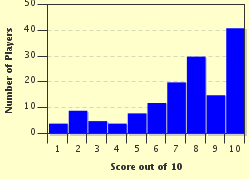Quiz Answer Key and Fun Facts
1. Little is known about the early life of Elmyr de Hory, as most details have only been made public in the biography "Fake!" by Clifford Irving. Why do many doubt the reliability of this information?
2. Not only do we know little of the early life of Elmyr de Hory, we are not even sure of his 'real' name, as he used many aliases at different stages of his career. Which of the following did he NOT use (as far as we know)?
3. In 1946, Elmyr de Hory sold his first fake to a friend who thought he was purchasing a drawing by what famous Spanish painter, known among other things as one of the founders of Cubism?
4. Elmyr de Hory discovered that he could get more money for his counterfeits when he moved from drawings to works in what medium?
5. During the 1950s Elmyr de Hory gained a reputation as an art dealer that led to recognition on several fronts. In 1951, he was made an honorary citizen and given a key to the city by the mayor of what southern American city?
6. According to some sources, one of the highlights of Elmyr de Hory's career as a counterfeiter was the sale of a 'Matisse' to the Fogg Art Museum, part of what famous Ivy League university?
7. In the context of his career, what was unusual about the sale of some art works by Elmyr de Hory to Chicago art dealer Joseph Faulkner in 1955?
8. A Texas oil magnate named Algur Hurtle Meadows is believed to have had one of the world's largest private collections of fake paintings, although that was not his intention when purchasing them. What art dealer informed Meadows that almost all of the paintings in his private collection were counterfeit?
9. During the last years of his life, Elmyr de Hory attained something of a celebrity status due to the publication of Clifford Irving's biography and the release of a film about his life called "F for Fake". No rosebuds were injured in the production of this film, the last major film to be released in the 20th century that was directed by what cinematic master?
10. What percentage of the major contemporary artworks displayed in museums at the start of the 21st century are generally acknowledged as being the work of Elmyr de Hory rather than of the artist whose signature appears on them?
Source: Author
looney_tunes
This quiz was reviewed by FunTrivia editor
bloomsby before going online.
Any errors found in FunTrivia content are routinely corrected through our feedback system.

